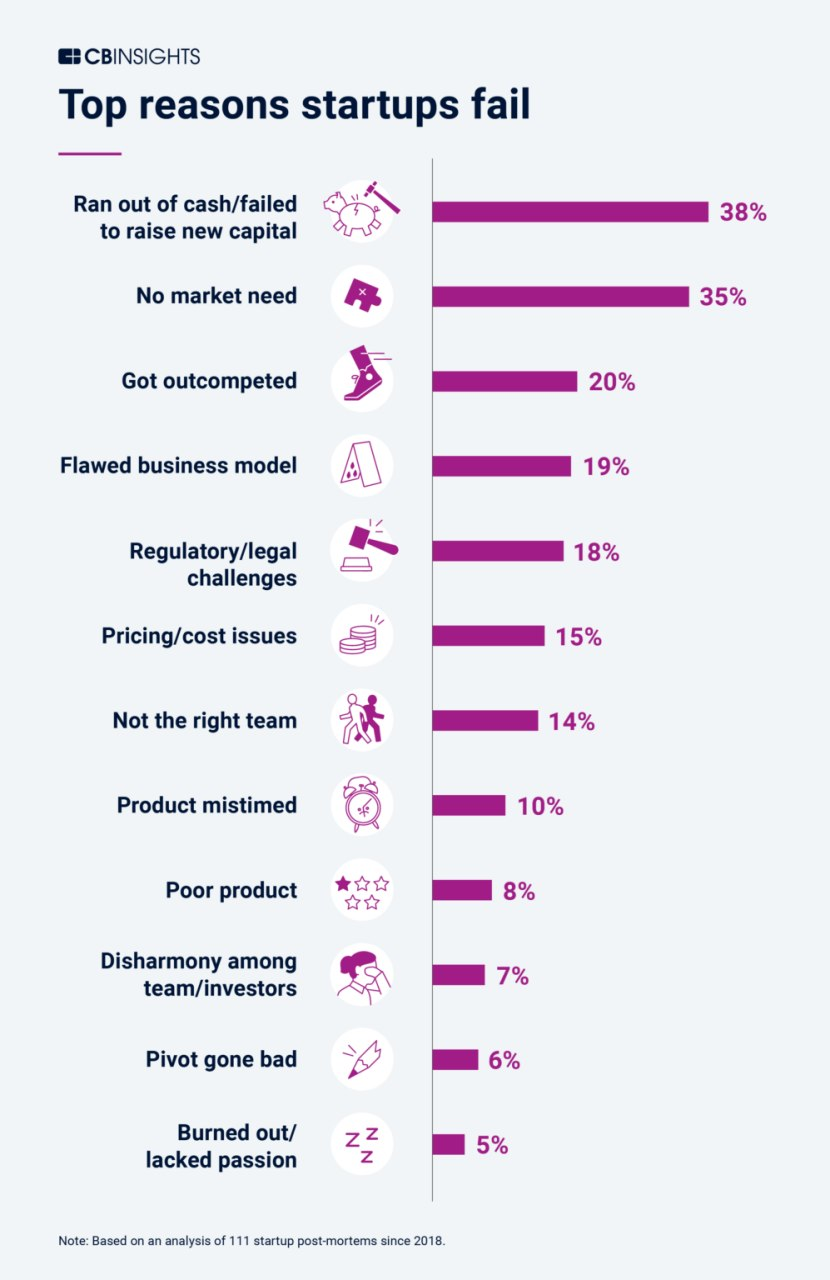
Creating a product startup can be an exciting experience, but it can be a daunting one as well. On average, only 1 out of 10 startups is successful, according to the Global Startup Ecosystem Report. Therefore, to raise your prospects, there are quite a number of important considerations to make in advance.
Bearing in mind everything you need when launching a startup is a challenging task, so it’d be a sound idea to rely on some well-established methodology. That's why we were inspired by the Systems Engineering methodology, presented in such industry standards as ISO 15288 and CFR21. In this article, we’ll make a brief overview of this methodology and highlight how it can help entrepreneurs to encompass and structure the process of creating and developing a startup.
What is the Systems Engineering Methodology (SEM)?
The Systems Engineering Methodology was developed to integrate such processes as systems and software engineering, project management, and quality assurance into a single framework that is easily manageable, reliable, and repeatable. It’s often used to streamline the development of various information systems throughout their life cycle, including the stages of requirements specification, design, testing, integration, management, and maintenance.
The systems engineering approach, therefore, covers a great deal of processes pertaining to the development cycle; however, it’s not concerned with operational management or systems implementation, as can be seen from this diagram:

In our experience, the SE methodology has proven exceptionally useful not only for developing information systems, but also for hardware products, medical equipment, and, in general, for managing a startup at certain phases of its maturation. Let’s now unpack what these phases are and how SEM can be of help.
Applying SEM at different stages of launching a startup
Concept development
The first thing you need to launch a startup is a viable idea. You need to know exactly what your startup is going to do—and make sure it’s something in demand and can be marketed. A CBInsights research shows that the second most frequent reason why startups fail is misreading market demand (35% of failure cases.)

So, if you don’t have a validated concept yet, you might need to take some time to consider different ideas, generally starting with what’s ‘hot’ at the moment. According to Nerd Wallet, some areas in the tech space that are hottest right now include food tech, web design, robotics, artificial intelligence, streaming services and many more.
The SEM approach implies a comprehensive concept development procedure that starts with identifying all business needs, requirements and expectations of stakeholders. Based on this data, a few solution concepts are then drafted and rigorously inspected to identify the most appropriate one. Concept benchmarking can be performed using the House of Quality matrix that enables comprehensive assessment and comparison of a number of solutions.
Identifying and engaging with stakeholders
If you’re creating a startup, you most likely have to deal with other stakeholders. These are not only co-founders, partners, or investors but virtually everyone who has a say in your business to this or that extent. For example, there’s an approach called UPIG that involves four different types of stakeholders: users, governance (management board, auditors, regulators), influencers and providers (suppliers and vendors.)
Obviously, they all have their own expectations and thoughts on how it all should work. While this can be a downside in some cases, because it means you can’t make 100% of the decisions on your own, it can also be a benefit since it enables you to consider multiple visions and get a more profound picture.
It’s essential to make sure you discuss everything with your stakeholders before you get too far in the company-building process. For example, you might want to elicit all the different needs, limitations and requirements that your stakeholders have while you’re working on things like product creation or overall business planning. By doing this, you’ll keep all your stakeholders happy and increase your chances of success.
The SE methodology views the process of identifying and engaging with stakeholders as an important stage of system development. The primary goal is to reach a mutual understanding between the business users and the project team in terms of specific project requirements and limits. Such tools as user stories and requirements traceability matrix are commonly used to compile all the data.
For startup owners, this approach might help formalize and structure the otherwise messy process of negotiating with stakeholders. For instance, the results can be presented in the form of ConOps (Concept of operations), a document stating a common understanding of the future enterprise in terms of operational and system-level requirements.
Project Management Planning
Once you’ve got a startup concept in place and agreed with the stakeholders upon how it should work, it’s time to actually start working toward the execution phase. You might approach it by creating a project management plan that will outline exactly what needs to be done and how it should be done. From there, you can better prepare your team for the next stages in the process.
Typically, a startup launching plan includes sections describing the overall idea, business model and goals, steps to be made with assigned responsible persons and deadlines, available resources, and so on. You can further elaborate on your development and marketing strategies, financial objectives, growth milestones, competitors analysis, etc. However, it's best to have a clear and concise action plan that can be easily implemented.
Within the SE paradigm, this stage is aimed at developing a Systems Engineering Management Plan (SEMP). This is a comprehensive document covering all aspects of the development project in terms of its technical and management processes. Often, SEMP is required for further state certification of the product or device. And while not all of the strict formalities of this document might be applicable for startup founders, its general structure might serve as a guideline to develop a startup launch roadmap.
Project kickoff
When it comes to the execution stage, entrepreneurs can draw a lot of actionable insights from the Project Management Body Of Knowledge (PMBOK).
There are 12 basic project management principles, which include:
Be a diligent, respectful, and caring steward
Create a collaborative project team environment
Effectively engage with stakeholders
Focus on value
Recognize, evaluate, and respond to system interactions
Demonstrate leadership behaviors
Tailor based on context
Build quality into processes and deliverables
Navigate complexity
Optimize risk responses
Embrace adaptability and resilience
Enable change to achieve the envisioned future state
You can find out more about these principles here.
Rules, Regulations, and Legalities
These are different laws and regulations that you may need (or want) to look into to make sure you’re on the right track and your business future is safe. According to CBInsights, legal and regulatory challenges account for 18% of all startup failures. Here are just a few examples of regulations and industry requirements worth considering.
ISO 15288
If you’re planning to start your own business in the fields of product development or systems engineering, you need to understand the generally accepted technical standards, which is where ISO 15288 comes in. This is a standard specific to systems engineering and it’s based on processes and lifecycle stages, specifically those for the International Organization for Standardization and the International Electrotechnical Commission.
In its core, this standard provides general processes related to the definition, control, and improvement of any stage of the lifecycle process, including hardware, software, data, processes, procedures, facilities, materials, and human resources.
FDA CFR21
Another consideration is the FDA’s CFR21, which outlines rules and requirements under the agency. This is something to consider when you’re going to work with anything that could be considered edible or a medical device.
There are a number of different certifications that you may need to obtain from FDA, and this is only one of the categories that you may need to consider. If your product is at all consumable or medical in nature you will need to reach out to the FDA for review and to get certified to sell your product. Here you can find the list of products that require FDA’s approval.
Getting a Patent
If you are creating a unique product or you will be running your business in some manner that is unique, you may want to apply for a patent. A patent can be filed on just about anything from the specific product you create to your logo and design. It could be related to a specific method of running your business or even the machinery that you use to create your product.
If there is anything unique about what you have to offer, there’s a possibility that you can get a patent on it. And if you can get a patent, you absolutely should. It will help protect you and your business as you continue to grow. Find out more about getting a patent with the US Patent and Trademark Office.
Make sure you don’t miss any other additional regulations or laws that apply to you as well as any ways in which you may be able to protect yourself and your business from those who might try to hamper your success.
Conclusion
When it comes to starting your own business, there is a large number of different factors to consider from the get-go. And, of course, there will be plenty of things to do as you’re continuing to develop it. Perhaps the most crucial thing is not to stop when you’re halfway there.